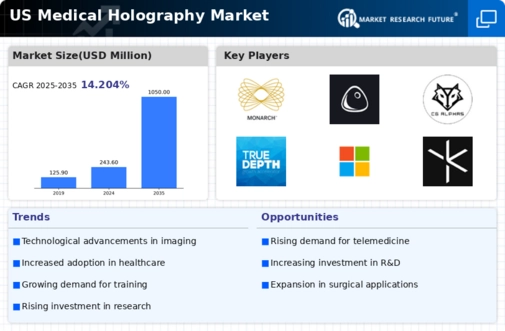Technological Advancements in Imaging
The medical holography market is experiencing a surge due to rapid technological advancements in imaging techniques. Innovations in holographic imaging systems enhance the visualization of complex anatomical structures, allowing for improved diagnostic accuracy. The integration of high-resolution displays and advanced algorithms facilitates real-time imaging, which is crucial for surgical planning and execution. As of 2025, the market is projected to grow at a CAGR of approximately 25%, driven by the increasing demand for precise imaging solutions in healthcare. This growth is indicative of the broader trend towards adopting cutting-edge technologies in medical practices, thereby enhancing the overall efficacy of patient care. The medical holography market is likely to benefit from ongoing research and development efforts aimed at refining these technologies further.
Growing Focus on Personalized Medicine
The medical holography market is increasingly aligned with the growing focus on personalized medicine. As healthcare shifts towards tailored treatment plans, the ability to visualize individual patient anatomy in three dimensions becomes paramount. Holographic imaging allows for the customization of surgical approaches based on unique anatomical variations, thereby enhancing the effectiveness of interventions. This trend is supported by the rising prevalence of chronic diseases, which necessitate more precise and individualized treatment strategies. The market for personalized medicine is expected to expand significantly, with estimates suggesting a growth rate of around 15% annually. This evolution in patient care is likely to drive the adoption of medical holography, as practitioners seek innovative ways to improve treatment outcomes.
Expansion of Medical Training and Education
The medical holography market is poised for growth due to the expansion of medical training and education programs. As educational institutions increasingly incorporate advanced technologies into their curricula, holographic imaging serves as a valuable tool for training future healthcare professionals. By providing immersive, three-dimensional representations of human anatomy, medical holography enhances the learning experience and improves retention of complex information. The demand for skilled professionals in the healthcare sector is on the rise, with projections indicating a need for over 2 million new healthcare workers by 2030. This growing emphasis on education and training is likely to stimulate interest in medical holography, as institutions recognize its potential to enhance educational outcomes and prepare students for modern medical practices.
Rising Demand for Minimally Invasive Procedures
The medical holography market is significantly influenced by the rising demand for minimally invasive procedures. As healthcare providers seek to reduce patient recovery times and minimize surgical risks, holographic imaging offers a compelling solution. By providing surgeons with detailed 3D visualizations of internal structures, medical holography enhances precision during procedures, thereby improving patient outcomes. Reports indicate that minimally invasive surgeries account for over 60% of all surgical procedures in the US, a trend that is expected to continue. This shift towards less invasive techniques is likely to propel the adoption of holographic technologies, as they align with the goals of modern surgical practices. Consequently, the medical holography market is poised for substantial growth as it caters to this evolving demand.
Increased Investment in Healthcare Infrastructure
The medical holography market is benefiting from increased investment in healthcare infrastructure across the US. Government initiatives and private sector funding are directed towards enhancing medical facilities and integrating advanced technologies. This investment is crucial for the development and deployment of holographic imaging systems, which require sophisticated infrastructure for optimal performance. As healthcare facilities upgrade their equipment, the demand for innovative solutions like medical holography is likely to rise. In 2025, healthcare spending in the US is projected to reach approximately $4 trillion, with a significant portion allocated to technological advancements. This financial commitment underscores the potential for growth within the medical holography market, as stakeholders recognize the value of investing in state-of-the-art imaging technologies.
























Leave a Comment